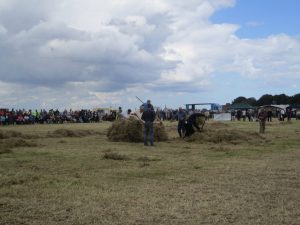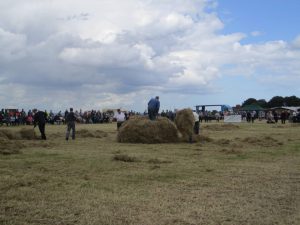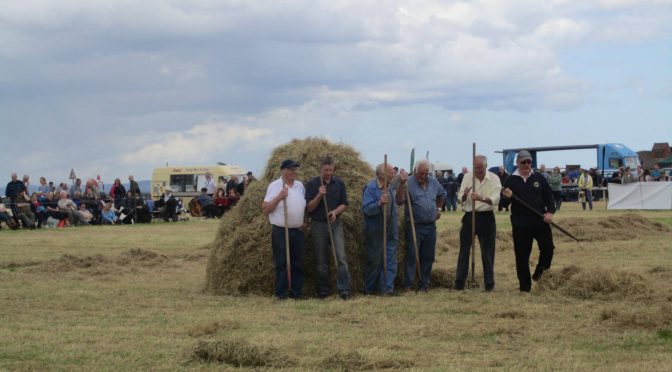Rucking hay was the last stage in making hay in the hayfield. In some parts of the country rucks were also known as tramp coles or ricks or even temporary stacks.
 By the time that rucks were to be made the drying grass was in coils, coles, cocks, small conical heaps of half-dried hay, the size of which varied according to the district and the season.
By the time that rucks were to be made the drying grass was in coils, coles, cocks, small conical heaps of half-dried hay, the size of which varied according to the district and the season.
In 1908 the Stephen’s Book the Farm noted that “the time hay should stand in the coil before being transferred to the stack is regulated solely by the dryness of the crop and the weather at the  time. Where the crop is light, and has been well dried before being put into the coil, it occasionally may be stacked the day following, should circumstances and the weather permit. In fact, during dry and settled weather it often is not coiled at all, although in most parts of Scotland, unless under exceptional circumstances, the practice is not considered a good one.”
time. Where the crop is light, and has been well dried before being put into the coil, it occasionally may be stacked the day following, should circumstances and the weather permit. In fact, during dry and settled weather it often is not coiled at all, although in most parts of Scotland, unless under exceptional circumstances, the practice is not considered a good one.”
Ruck-making was hard work. It involved a lot of forking! There was also an art to it. The forkers chose a location in the field which was in the centre of a number of coils. Their hay from these coils was to be used to form the basis for the ruck. Coils that were further away were brought nearer the ruck and forked onto it.
 The forkers had to make sure that the hay was evenly forked onto the ruck so that one side of the ruck didn’t want to slide off – that would never do! When the ruck was built the loose hay was raked off so that it would be waterproof. Rucks were left until the hay had dried further when they were moved by a hay sledge, used to take the rucks into the stackyard.
The forkers had to make sure that the hay was evenly forked onto the ruck so that one side of the ruck didn’t want to slide off – that would never do! When the ruck was built the loose hay was raked off so that it would be waterproof. Rucks were left until the hay had dried further when they were moved by a hay sledge, used to take the rucks into the stackyard.
If you know anyone that made hay in the old-fashioned way, ask them about ruck-making. Y ou’ll get an interesting story from them!
The photographs were taken at the Fife Vintage Agricultural Machinery Rally, June 2014.
© 2016 Heather Holmes
